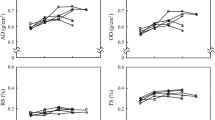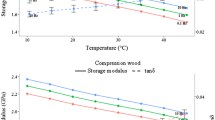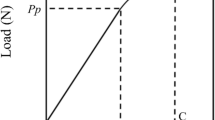Abstract
12 years old trees from 20 progenies/provenances of Japanese larch (Larix kaempferi, [Lamb.] Carr.), planted in Quebec, were sampled to study the variation in selected mechanical properties. Two standard wood samples and one 10-mm diameter increment core were taken from each tree at breast height. The parallel-to-grain compliance coefficient and ultimate crushing strength were evaluated on the standard samples at air-dry conditions. The dynamic compliance coefficient was measured on increment cores using an ultrasonic wave propagation method. Differences in all mechanical properties among progenies/provenances were significant. Lowest static compliance coefficient and highest ultimate crushing strength were found in progenies/provenances 8934, 7795, 7283, 8962, 8907, 7794, and 8939, being the most interesting for a lumber end-use. Among them, progenies/provenances 7283, 8934, 7794, 7795, 8962, and 8907 also showed lowest dynamic compliance coefficient. The latter coefficient tended to be lowest near the pith and then increased outward towards the bark. There was also a highly significant correlation between static mechanical properties, and a moderate correlation between static and dynamic compliance coefficients. Ultimate crushing strength was moderately correlated to wood density.

Similar content being viewed by others
References
Alteyrac J, Cloutier A, Ung CH, Zhang SY (2006) Mechanical properties in relation to selected wood characteristics of black spruce. Wood Fiber Sci 38:229–237
Apiolaza LA (2009) Very early selection for solid wood quality: screening for early winners. Ann For Sci 66:601p1–p10
Auty D, Achim A (2008) The relationship between standing tree acoustic assessment and timber quality in Scots pine and the practical implications for assessing timber quality from naturally regenerated stands. Forestry 81:475–487
Bastien J-Ch, Keller R (1980) Intérêts comparés du Mélèze hybride (Larix × eurolepis Henry) avec les deux espèces parentes. Rev Forest Fr 32:521–530
Beaudoin M, Masanga BO, Poliquin J, Beauregard RL (1989) Physical and mechanical properties of plantation grown tamarack. Forest Prod J 39:5–10
Brashaw BK, Bucur V, Divos F, Goncalves R, Lu JX, Meder R, Pellerin RF, Potter S, Ross RJ, Wang XP, Yin YF (2009) Nondestructive testing and evaluation of wood: a worldwide research update. Forest Prod J 59:7–14
Bucur V (1981) Wood dynamical young modulus determination on increment core. Ann Sci Forest 38:283–298
Bucur V (1983) An ultrasonic method for measuring the elastic-constants of wood increment cores bored from living trees. Ultrasonics 21:116–126
Bucur V, Böhnke I (1994) Factors affecting ultrasonic measurements in solid wood. Ultrasonics 32:385–390
Cáceres CB, Hernández RE, Fortin Y, Beaudoin M (2017) Wood density and extractive content variation among Japanese larch (Larix kaempferi, [Lamb.] Carr.) progenies/provenances trials in Eastern Canada. Wood Fiber Sci 49:363–372
Cáceres CB, Hernández RE, Fortin Y (2018) Shrinkage variation in Japanese larch (Larix kaempferi, [Lamb.] Carr.) progenies/provenances trials in Eastern Canada. Wood Mater Sci Eng 13:97–103
Canadian Wood Council (2017) Machine graded lumber. http://cwc.ca/wood-products/lumber/machine-graded/. Accessed 05 July 2017
Cave ID, Walker JCF (1994) Stiffness of wood in fast-grown plantation softwoods—the influence of microfibril angle. Forest Prod J 44:43–48
Charron S, Jourez B, Marchal M, Hebert J (2003) Comparison study of physical and mechanical characteristics of European (Larix decidua Mill.), Japanese (Larix kaempferi (Lambert) Carr.) and hybrid (Larix x eurolepis Henry) larch woods. Biotechnol Agron Soc Environ 7:5–16
Chauret G, Zhang SY (2002) Wood characteristics and end-use potential of two fast-growing exotic larch species (Larix gmelinii and Larix siberica). In: Grown in Ontario. Report Project No. 3563. Forintek Canada Corp., Quebec
Chen Z-Q, Karlsson B, Lundqvist S-O, García Gil MR, Olsson L, Wu HX (2015) Estimating solid wood properties using Pilodyn and acoustic velocity on standing trees of Norway spruce. Ann For Sci 72:499–508
Chui YH, MacKinnon-Peters G (1995) Wood properties of exotic larch grown in Eastern Canada and Northeastern United States. Forest Chron 71:639–646
Cown DJ, Hebert J, Ball R (1999) Modelling radiata pine lumber characteristics. Part 1: Mechanical Properties of small clears. New Zeal J For Sci 29:203–213
Einspahr DW, McDonough TJ, Joachimides T (1983) Kraft pulping characteristics of European, Japanese, and European x Japanese larch hybrids. Tappi J 66:72–76
Farrar JL (1995) Trees of the northern United States and Canada. Fitzhenry and Whiteside Ltd., Ottawa
Fischer C, Vestøl GI, Øvrum A, Høibø OA (2015) Pre-sorting of Norway spruce structural timber using acoustic measurements combined with site-, tree- and log characteristics. Eur J Wood Prod 73:819–828
Forest Products Laboratory. 2010. Wood handbook—wood as an engineering material. General Technical Report FPL-GTR-190. Madison, WI
Hernández RE, Koubaa A, Beaudoin M, Fortin Y (1998) Selected mechanical properties of fast-growing poplar hybrid clones. Wood Fiber Sci 30:138–147
Herzig L (1991) Évaluation du module d’Young de bois d’épinette par méthode ultrasonore sur carottes de sondage. [Young`s modulus evaluation of white spruce wood by the ultrasonic method in increment cores] Mémoire (M. Sc.), Université Laval
Isebrands JG, Hunt CM (1975) Growth and wood properties of rapid-grown Japanese larch. Wood Fiber Sci 7:119–128
Jacques D, Marchal M, Curnel Y (2004) Relative efficiency of alternative methods to evaluate wood stiffness in the frame of hybrid larch (Larix × eurolepis Henry) clonal selection. Ann For Sci 61:35–43
Jessome AP (2000) Strength and related properties of woods grown in Canada. Special publication SP-514E. Forintek Canada Corp., Quebec
Keith CT, Chauret G (1988) Basic wood properties of European larch from fast-growth plantations in Eastern Canada. Can J For Res 18:1325–1331
Labrecque G (1992) Relation entre les propriétés mécaniques mesurées en flexion statique et le module d’Young dynamique mesuré sur carotte de sondage. [Relationship between static bending properties and dynamic Young’s modulus measured in an increment core] Rapport interne de projet d’études. Département des sciences du bois, Université Laval, Québec
Legg M, Bradley S (2016) Measurement of stiffness of standing trees and felled logs using acoustics: A review. J Acoust Soc Am 139:588–604
Loo J, Fowler DP, Schneider MH (1982) Geographic-variation in specific gravity among Japanese larch from different provenances. Wood Fiber Sci 14:281–286
MRNF (2007) La forêt québécoise et sa gestion. [The Quebec forest and its management]. Ministère des Forêts, Faune et Parcs, Gouvernement du Québec. http://mffp.gouv.qc.ca/publications/forets/comprendre/gestion-forestiere.pdf. Accessed 05 July 2017
NFDP (2015) National forestry database. Silviculture—data compendium. http://nfdp.ccfm.org/data/compendium/html/comp_68e.html. Accessed 14 Nov 2017
NGLA (2003) Standard grading rules for Canadian lumber. National lumber grades authority, New Westminster, BC
NRCAN (2017) Machine stress rated lumber. http://www.nrcan.gc.ca/forests/industry/products-applications/15841. Accessed 14 Nov 2017
Pâques LE, Millier F, Rozenberg P (2010) Selection perspectives for genetic improvement of wood stiffness in hybrid larch (Larix × eurolepis Henry). Tree Genet Genomes 6:83–92
Paradis N, Auty D, Carter P, Achim A (2013) Using a standing-tree acoustic tool to identify forest stands for the production of mechanically-graded lumber. Sensors 13:3394–3408
Perron M (2011) Le mélèze hybride du Québec: performant et racé. [The hybrid larch of Quebec: improved and efficient]. Note de recherche forestière no 3. Ministère des Forêts, de la Faune et des Parcs, Québec
Rainville A, Desponts M, Beaudoin R, Périnet P, Mottet M-J, Perron M (2003) L’amélioration des arbres au Québec: un outil de performance industrielle et environnementale. [Improving trees in Quebec: an industrial and environmental performance tool]. Note de recherche forestière no 127. Ministère des Forêts, de la Faune et des Parcs, Quebec
SAS Institute (2012) SAS package version 9.4. SAS Institute, Cary
Shmulsky R, Jones PD (2011) Forest products and wood science: an introduction, 6th edn. Wiley-Blackwell, London
Stipanicic A (1975) L’amélioration du genre mélèze (Larix sp.) au service de la recherche du Ministère des terres et forêts. [Improvement of the larch species (Larix sp.). In: in the research department of the Ministry of lands and forests]. Note de recherche forestière no 20. Ministère des Forêts, de la Faune et des Parcs, Quebec
Urhan OS, Kolpak SE, Jayawickrama KJS, Howe GT (2014) Early genetic selection for wood stiffness in juvenile Douglas-fir and western hemlock. Forest Ecol Manag 320:104–117
Verville A (1981) Étude physico-mécanique de quelques espèces du genre Larix en plantation. [Physico-mechanical study of some species of the genus Larix in plantation]. Mémoire (M.Sc.), Université Laval
Yang JL, Evans R (2003) Prediction of MOE of eucalypt wood from microfibril angle and density. Holz Roh Werkst 61:449–452
Yang JL, Fortin Y (2001) Evaluating strength properties of Pinus radiata from ultrasonic measurements on increment cores. Holzforschung 55:606–610
Zhang SY, Koubaa A (2008) Softwoods of Eastern Canada: Their silvics, characteristics, manufacturing and end-uses. FP Innovations, Quebec
Zhu JJ, Nakano T, Hirakawa Y (2000) Effects of radial growth rate on selected indices for juvenile and mature wood of the Japanese larch. J Wood Sci 46:417–422
Zobel B, Jett JB (1995) Genetics of wood production. Springer, Berlin
Acknowledgements
Funding for this project was provided by the Ministry of Forests, Wildlife, and Parks of Quebec. The authors thank Ante Stipanicic and Michel Beaudoin for their valuable assistance. The authors also thank Hristo Iliev for his contribution during the laboratory experiments
Author information
Authors and Affiliations
Corresponding author
Rights and permissions
About this article
Cite this article
Cáceres, C.B., Hernández, R.E. & Fortin, Y. Variation in selected mechanical properties of Japanese larch (Larix kaempferi, [Lamb.] Carr.) progenies/provenances trials in Eastern Canada. Eur. J. Wood Prod. 76, 1121–1128 (2018). https://doi.org/10.1007/s00107-018-1302-3
Received:
Published:
Issue Date:
DOI: https://doi.org/10.1007/s00107-018-1302-3




